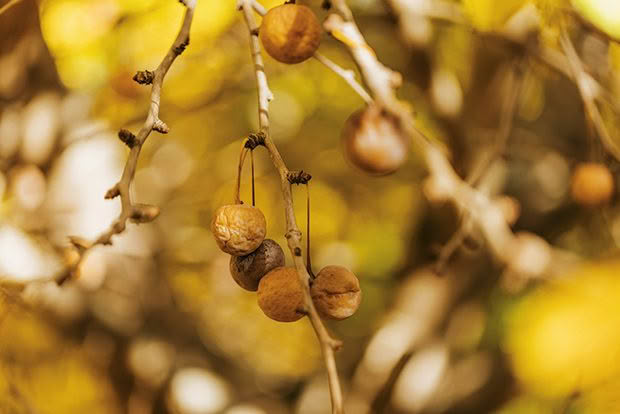Stinky, healthy, delicious: Why people love or hate the ginkgo nut

In autumn and winter, the leaves of the ginkgo turn a vibrant yellow and gold.
It’s infamous for the assaulting odour of its fruit, but the majestic and ancient ginkgo tree can be a forager’s shrine if properly understood.
Words: Michael Andrew Photos: Justin Aitken
Some may describe the smell as vomit. Others – as rancid butter. It’s even been likened to dog poo. In fact, during certain times of the year, it’s possible to hear just about every foul comparison imaginable to describe the foetid aroma of the falling fruit of the ginkgo tree (Ginkgo biloba).
Which is why, to most New Zealanders, the sight of anyone gathering under ginkgo trees during autumn and rummaging through the slimy, foul-smelling litter in search of edible food is a peculiar spectacle. Those doing the rummaging, however, know exactly what they’re looking for. Underneath the noxious flesh is a delicacy that has been revered and coveted by Asian cultures for centuries – the ginkgo nut.

An ingredient in many Chinese, Korean and other Asian dishes, the nut is prized for its mild flavour and creamy texture and is widely used as both a snack and in celebratory dishes. Its supposed health benefits means it features prominently in Traditional Chinese Medicine.
In New Zealand, although ginkgo trees are everywhere, the nut is largely unknown to most non-Asian New Zealanders. Even those with ginkgo trees on their blocks tend to shun the fruit, mostly because of its smell.
However, that doesn’t mean interest in ginkgo isn’t growing.
Helen Turnbull is the chef and owner at Kāpiti Coast restaurant, 50-50. A few years ago, a local arborist and forager began bringing her rare and interesting ingredients from properties and blocks he’d worked on around the region. Among the foraged material were ginkgo nuts. Having lived in Japan and worked with the nuts before, Helen started using them in her cooking.

“I served them like I did in Japan, as a bar snack and also in a couple of dishes. Their flavour is not super strong. It’s way more about the texture,” she says.
“It’s very different. You don’t really get that kind of texture from anything else.”
Despite the novelty, the reception has been positive from 90% of Helen’s customers. It allows her to share information about the nuts and their history with her patrons. “They’re really keen on trying something new. Textural things can be a bit polarising but there’s a lot of interest in ginkgo.”
FORAGING

Although ginkgo are relatively common in New Zealand, not every tree will bear fruit. Ginkgo is dioecious, meaning each tree is either male or female. A fruiting tree must be female and be at least 20 years old, after which it will produce a prolific volume of golden fruit. Once dropped and squashed on the ground, the fruit releases the notorious odour. The flesh of the ginkgo fruit is inedible, and in fact contains urushiol, a mixture of organic compounds that’s also found in poison ivy and can cause skin irritation; people will typically use gloves when handling the fruit. The best time to forage is in late autumn, after the flesh has been softened by wind and rain. People will squeeze the nut into a bag, leaving behind as much flesh as possible. The nuts are then washed and can be frozen in their shells for later use.
NUT VS LEAVES

Along with the smell of the fruit, ginkgo trees are equally famous for their leaves, which turn a vibrant canary yellow in autumn and are used for their cognitive-enhancing medicinal properties. However, the supposed health benefits of the leaves are distinct from that of the nuts.
In Traditional Chinese Medicine, consumption of the nuts as part of a formula is believed to stop coughing and expel phlegm, and can be used to alleviate conditions like asthma and whooping cough. Although the health benefits of the nuts are supported mostly by anecdotal evidence, the leaves have been given much more attention in clinical research. The leaf extract is a common ingredient in many supplements, and advocates say ginkgo can help with cognitive function and reduce the symptoms of neurological conditions like alzheimers and dementia.

The leaf extract is rich in antioxidants and contains high levels of flavonoids and terpenoids, which can neutralise the damaging effects of free radicals and reduce inflammation.
Love this story? Subscribe now!
 This article first appeared in NZ Lifestyle Block Magazine.
This article first appeared in NZ Lifestyle Block Magazine.
